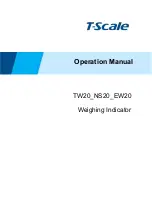
Version 1
13
How to locate leaks
1. Use the TRISONIC SCANNING MODULE.
2. Select the LOG setting on the meter selection dial.
3. Use "fixed-band" position on the Frequency selection dial. If too much background noise is present,
try some of the shielding methods listed below.
4. Start off with the sensitivity selection at 10 (Maximum).
5. Begin to scan by pointing the module towards the test area. The procedure is to go from the "gross"
to the "fine" more and more subtle adjustments will be made as the leak is approached.
6. If there is too much ultrasound in the area, reduce the sensitivity setting and continue to scan.
7. If it is difficult to isolate the leak due to competing ultrasound, place the RUBBER FOCUSING
PROBE over the scanning module and proceed to scan the test area.
8. Listen for a "rushing" sound while observing the meter.
9. Follow the sound to the loudest point. The meter will show a higher reading as the leak is
approached.
10. In order to focus in on the leak, keep reducing the sensitivity setting and move the instrument closer
to the suspected leak site until you are able to confirm a leak.
To Confirm a Leak
Position the Trisonic Scanning Module, or the rubber focusing probe (if it is on the scanning module) close
to the suspect leak site and move it, slightly, back and forth, in all directions. If the leak is at this location,
the sound will increase and decrease in intensity as you sweep over it. In some instances, it is useful to
position the rubber focusing probe directly over the suspect leak site and push down to "seal" it from
surrounding sounds. If it is the leak, the rushing sound will continue. If it is not the leak site, the sound will
drop off.
Overcoming Difficulties
Competing Ultrasounds If competing ultrasounds make it difficult to isolate a leak, there are two
approaches to be taken: Manipulate the environment. This procedure is fairly straightforward. Men
possible, turn off the equipment that is producing the competing ultrasound or isolate the area by
Closing a door or window.
Manipulate the instrument and use shielding techniques. If environmental manipulation is not
possible, try to get as close to the test site as possible, and manipulate the instrument so that it is
pointing away from the competing ultrasound. Isolate the leak area by reducing the sensitivity of
the unit and by pushing the tip of the rubber focusing probe up to the test area, checking a small
section at a time. In some extreme instances, when the leak check is difficult in the fixed band
mode of the frequency selection dial, try to "tune in" to the leak sound by "tuning out" the problem
sound. In this instance adjust the frequency selection dial until the background sound is minimized
and then proceed to listen for the leak.














































